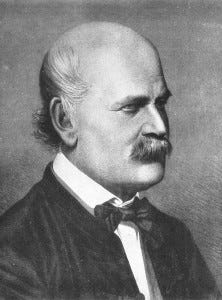‘In 1850, Ignaz Semmelweis saved lives with three words: wash your hands’
On this date in 1850, a prickly Hungarian obstetrician named Ignaz Semmelweis stepped up to the podium of the Vienna Medical Society’s lecture hall. It was a grand and ornately decorated room where some of medicine’s greatest discoveries were first announced. The evening of May 15 would hardly be different — even if those present (and many more who merely read about it) did not acknowledge Semmelweis’s marvelous discovery for several decades.
Ignaz Semmelweis, circa 1860. Photo via Wikimedia
‘What, exactly, was the doctor’s advice to his colleagues on that long ago night? It could be summed up in three little words: wash your hands!
At this late date, we all expect our doctors to wash their hands before examining us or performing an operation in order to prevent the spread of infection. Surprisingly, physicians did not begin to acknowledge the lifesaving power of this simple act until 1847
It was then that Dr. Semmelweis began exhorting his fellow physicians at the famed Vienna General Hospital (Allgemeines Krankenhaus) to wash up before examining women about to deliver babies. His plea was far more than aesthetic; it was a matter of life and death and helped to prevent a deadly malady known as “childbed” or puerperal (from the Latin words for child and parent) fever.’
Please support Dr. Tenpenny’s work.
‘Follow: Twitter | Instagram | Telegram | Truth Social | Podcast Membership|
Broadcasts: Rumble| HappyHour |This Wk wDrT | Brighteon | Bitchute | Tues Coffee
Learn about ECP: Health Center Cleveland, OH | Health Center Ventura, CA
Websites: DrTenpenny.com |Tenpenny Apparel| Tenpenny Supplements
++++++++++++++++++++++++++++++++++++++++++++++++++++++++++++++++++++++++++++
Just prior to the turn of the century, sporadic attempts were made to improve sanitation. Cities began to pave roads, institute garbage collection, and construct garbage dumps. The early water treatment plants had systems that were inadequately designed and often became clogged with human excrement and animal debris from the street.
It’s difficult to imagine the state of filth that Americans had become accustomed to living within the early 1900s. The 1912 annual report from the New York City Health Department included,
“…the removal of 20,000 dead horses, mules, donkeys and cattle from the streets in addition to nearly half a million smaller animals such as pigs, hogs, calves, and sheep, which amounted to disposal of more than 5 million pounds of spoiled poultry, fish, pork and beef which eventually ended up in the municipal water supplies.”
It’s no wonder that the report also highlighted the sheer volume of complaints-over 343,000 in total-about the foul smell due to poor ventilation and unlicensed manure dumps. (source: pg. 11).
In 1872, the introduction of water filtration in the US was a significant step towards improving public health. Initially aimed at addressing discoloration and removing bad taste and foul odor, filtration soon proved to be a game-changer. It not only eliminated turbidity, foul color, and nearly 99% of the swarming bacteria but also set a new standard for the “quality” of treated water.
However, when outbreaks continued to occur, chemists experimented with several disinfecting methods, including boiling, ultraviolet rays, ozone, copper, silver, and chlorine. However, cost considerations and ease of use produced a clear winner: chlorine.
First used in the paper and textile industries, calcium hypochlorite, a stable, white solid that contains 65% available chlorine and dissolves easily in water, was cheap, readily available, and easy to use on a large scale. It was already being used to clean the water in the Chicago Stockyards.
Jersey City, New Jersey, was the first urban city to use chlorine to clean up its water. In 1899, the city contracted to build a dam, a reservoir, and a pipeline to deliver water to the city from the Rockaway River, 23 miles away. When it was completed, city officials were not pleased with the outcome. At certain times of the year, sewage water polluted the reservoir and the city water. A lawsuit was filed on the grounds that the water was not “pure and wholesome” as was required by the contract. The construction company was forced to remove the sources of contamination and build a new watershed area. Once completed, the City filed another lawsuit, balking at the steep price tag, equivalent to more than $175 million in today’s dollars.
Bacteriological techniques had advanced in the time it took to construct the new dam. Engineer George Warren Fuller was retained to build a chlorine feed system to deliver millions of gallons of decontaminated water per day to the city. From the first day of implementation, it has continued to feed various forms of chlorine into the water supply. September 26, 2016, marked the 108th year of continuous use of chlorine in the water supply.
Following the successful implementation of chlorination in Jersey City, many other cities quickly adopted this method with impressive results. In 1900, waterborne diseases accounted for nearly one-fourth of all reported deaths in major cities. By 1936, with the widespread introduction of clean water technologies to municipal water, overall mortality was reduced from infectious causes by about 43%. In 1941, it was estimated that 85% of U.S. drinking water was chlorinated. Clean water technologies, sand filtration combined with chlorination, reduced typhoid fever mortality by more than 90% by 1956.
The cornerstone of this revelation and review comes from a paper by Cutler and Miller from Harvard University, published in 2004:
“Our results also suggest that clean water was responsible for a 74% decline in infant mortality and nearly 62% decline in child mortality. The magnitude of these effects is striking. Clean water also appears to have led to the near eradication of typhoid fever [and other] scourges such as pneumonia, tuberculosis, meningitis, diphtheria, and croup. Clean water technologies are likely the most important public health intervention of the 20th Century.”
The massive number of immigrants who came to the U.S. in the late 1800s brought with them pathogens associated with poor hygiene. Four vaccines—against typhoid fever, cholera, rabies, and plague—had been developed late in the 1800s, but none were widely used, nor were they very effective. Few treatments existed for infection. Penicillin, the first antibiotic, was not discovered until 1929 and not put into widespread use until the early 1940s. The only routinely given vaccination was smallpox.
By 1868, more than 95% of Chicago’s inhabitants had been inoculated with the smallpox vaccine. After the Great Chicago Fire of 1871, vaccination was required to receive relief supplies. Despite a near-100% vaccination rate, the city was hit with a devastating smallpox epidemic in 1872. More than 2,000 persons contracted smallpox, and more than 25% of those infected died. The fatality among children under five was the highest ever recorded.
Vaccinating the entire city did not create herd immunity, and it did not protect the population from contracting smallpox. Despite these—and many other failures—vaccination is continually promoted as one of the “greatest medical achievements of modern civilization.” The real heroes, the technology that changed the course of history and public health, are rarely mentioned: clean water, sewage treatment for municipalities, and electricity to support refrigeration.
In the 21st century, more than half of the world’s population, more than 3 billion people, live in small cities or rural towns. Most of the poor have no access to clean drinking water or reliable sanitation. In fact, the majority of people worldwide still practice open defecation. Coupled with inadequate nutrition and no refrigeration to protect food from flies, maggots, and other pathogens, health issues and infections continue to be a major problem and primary cause of death in Third World nations. As far back as 2005, the World Bank, in conjunction with the World Sanitation Program (WSP.org), found a 47% reduction in diarrhea and death by dehydration among children in remote villages.
Rotary International, the WHO, UNICEF, GAVI, WEF, and the Gates Foundation have poured tens of billions of dollars into vaccinating malnourished children who lack sanitation, water, refrigeration, and education. Instead of pushing money into polio, measles, and rotavirus vaccines, think of the global problems that would have been solved if those same dollars had been allocated to the most important health intervention in the world’s history: Clean Water.
Notes:
Information on chlorine in the water supply was taken from several sources:
-
Documentary History of American Water-works
-
“The Chlorine Revolution: Water Disinfection and the Fight to Save Lives.” Michael J. McGuire. American Water Works Association. 2014.
-
Summary Report: Drinking Water and Health. National Academy of Sciences. 1977. pg. 68-72.
-
“The Role of Public Health Improvements in Health Advances: The 20th Century United States,” by David Cutler and Grant Miller. Harvard University. February, 2004. PMID: 15782893, DOI: 10.1353/dem.2005.0002
-
“Medicine in Chicago 1850–1950: A Chapter in the Social and Scientific Development of a City, American History Research Center,” Thomas Neville Bonner. Madison, Wisconsin, 1957, p. 182.’
___
You must not wait for another catastrophic crisis (at times manufactured but we are prevented from making our own basic personal decisions or accessing needed drugs and response tools) to catch you off-guard. We must take charge and be prepared today so that we can enjoy peace of mind tomorrow.
Enter the Wellness Company as a solution and a willing participant in the health care conversation. The Wellness Company, launched in 2022, offers health care, prescriptions, and supplements, all backed by research
The Wellness Company isn’t chasing profits — it’s trying to help people recover. While the government continues pushing vaccines, The Wellness Company is focusing on real solutions.
From telemedicine, prescriptions, memberships, and supplements, TWC is leading America with alternative choices to the traditional health care model.
Please consider support of a good PATRIOT company (in this PATRIOT economy) Drs. McCullough, Risch, Thorp, myself support (they are our sponsors), The Wellness Company; see the emergency preparation kit (key component being antibiotics you were denied by doctors, pharmacists, governments during the fraud COVID), first aid kit, travel emergency kit, contagion control kit etc. Please consider the SPIKE SUPPORT (spike protein DETOX dissolving spike from mRNA vaccine, this is critical to remove spike form the mRNA vaccine/and DNA viral vector) formula with NATTOKINASE as well as the triple formula (SPIKE SUPPORT, BROMELAIN, CIRCUMIN)
If you wish to give a donation to help me, you can at:
Zelle:
Or Ko-Fi
Ko-fi.com/drpauleliasalexander
Or to my address at:
150 South 8th Street
Unit 170
Lewiston, New York
14092
Alternatively, please consider going from an UNPAID subscriber or follower to a PAID at $5 per month or $30 per year. This can provide me help. If this is not possible at this time, this is ok, please remain a subscriber for FREE and there is no difference between FREE and PAID. No restrictions.
Click this link for the original source of this article.
Author: Dr. Paul Alexander
This content is courtesy of, and owned and copyrighted by, https://palexander.substack.com and its author. This content is made available by use of the public RSS feed offered by the host site and is used for educational purposes only. If you are the author or represent the host site and would like this content removed now and in the future, please contact USSANews.com using the email address in the Contact page found in the website menu.













